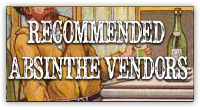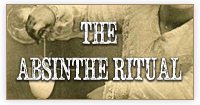Absinthe.se
The premier independent absinthe resource since 2003
I sit at my door, smoking a cigarette and sipping my absinthe, and I enjoy every day without a care in the world.
- Paul Gaugin, 1897
Absinthe FAQ
I get a lot of questions about absinthe both here through this site and in real life. Not surprisingly many of these questions were the same coming in over and over again and many based on old beliefs and rumours. So, to straighten things out I've put together a little FAQ covering the most common questions I get.
- What is absinthe?
- What does absinthe taste like?
- Is absinthe a drug or poison, and will it get me high?
- If absinthe is not a drug, then why was it banned?
- What's the legal status of absinthe today?
- How do I prepare my absinthe before drinking?
- I've seen movied with absinthe and fire, what's that?
- How is absinthe made?
- I've seen "absinthe making kits" on the internet, can I use those?
- What about thujone?
- So, what absinthe contains the most thujone?
- How about Czech absinth? Isn't that the only "real" one today?
- Are "real absinthes" really available today?
- Which absinthe should I get?
- Where can I buy absinthe?
What is absinthe?
Absinthe is a tasty anise-based aperitif. To be enjoyed and sipped as any other aperitif. Absinthe is known for its green color which is obtained from the use of herbs to color the distillate in production. Other colors exist but are less common. Traditionally absinthe was green or completely transparent.
It is a high proof liquor with an alcohol level commonly between 55% and 72% However, there are absinthes at both lower and higher strengths than those.
A whole lot of rumours and myths exist around absinthe. Most of them completely untrue but some of course include atleast a bit of reality. The ones most common are those that tell you that absinthe will make you go mad, cut off your ears, see little green fairies and all kinds of things. Absinthe will do neither of this.
What does absinthe taste like?
Absinthe is an anise-based drink. Of all the ingredients in absinthe anise is one of the absolute key players and makes up the greatest portion in most recipes. There are absinthes on the market that claims to be "anise free absinthe" which pretty much would mean that they are not really to be considered absinthes, atleast not in the aspect of what classic, properly made Belle Epoque style absinthe is. Of course there is more to it than anise, and all other herbs lends their own unique flavour to absinthe as well. However, absinthe will always carry an anise taste.
Is absinthe a drug or poison, and will it get me high?
No. Neither of this is true. Absinthe is not a drug and it will not show up on a drug test, unless the test is specifically made to detect traces of any of the (very common) ingredients of absinthe.
Many myths and rumours about absinthe's hallucinogenic properties have been floating around for ages and ages. Absinthe is not hallucinogenic though and it will not get you high. It was previously believed that thujone, from wormwood, had the same properties as THC because they had a similar molecualr structure. This has since been proven completely untrue. Thujone has no relation to THC or anything else remotely close to Cannabis.
If absinthe is not a drug, then why was it banned?
This is a very long story and it is explained and told in the History and facts section of this site. However to put it in short, it goes something like this.
There was a very powerful temperance movement who saw absinthes popularity among the people as a huge threat. The temperance movement together with the wine industry which saw much of its profits eaten by absinthe did all in their power to put an end to absinthe. Scientific research, often paid by the wine industry and the temperance movement, was done to find proof that absinthe caused all kinds of health problems and had to be stopped. "Absinthism" was coined and supposed to be caused by absinthe.
The effects of absinthism were all very much like those of alcoholism but this was a long time ago...
Fuelled by the notorious "Lanfray murders", where a farmer shoots part of his family are blamed on absinthe, as were other crimes, the temperance movement gained a lot of ground and absinthe took one step closer to its grave.
Thujone was found as a part of absinthe and studies made on thujone showed that thujone caused severe damage to your body and eventually killed you. Of course, those studies were made on little fluffy lab critters and they were injected pure thujone and wormwood oil in amounts not obtainable from drinking absinthe. Science were not very well regulated and even accurate in those days.
Lots of things were done by the largest absinthe manufacturers to meet this and they worked hard to prove that absinthe wasn't dangerous. However, in the end the temperance movement won and absinthe was banned in several countries around the time of 1910-1915.
What's the legal status of absinthe today?
Absinthe is legal in all of Europe today as well as in most of South-America and in Canada. Absinthe was banned in the U.S.A because of restrictions on thujone content up until late 2007 when the regulations where slightly altered. Since then several authentic absinthes have been released on the market in the U.S and also some U.S made absinthes have seen the light of day.
Common belief is that absinthe was banned all over the world and only remained legal in Portugal for a long time. This is not true... Absinthe was never banned in Spain where production of absinthe kept on going and actually never stopped. Absinthe was never banned in Sweden or Denmark as well as the U.K and of course, Portugal. It is highly likely that there are several other countries in which absinthe was never banned, simply because absinthe never posed either a health problem or a "threat" to other liquors there.
How do I prepare my absinthe before drinking?
The proper way to prepare an absinthe is to dillute it with water. You would typically pour a measure of absinthe (about 3cl) into a glass and slowly add iced water to this. The water to absinthe ratio ranges from 3:1 up to 5:1 depending on personal preference and alcoholic strength of the absinthe itself.
Sugar can be added to sweeten the drink and in some cases bring forward certain flavour profiles of the drink. This is typically done by placing a slotted spoon, an absinthe spoon, on top the glass containing the absinthe. A sugar cube is placed on the spoon onto which iced water is slowly dripped. Drop by drop the water dissolves the sugar which drips into the absinthe. Water is continously added until the desired ratio is reached.
Illustrations on further instructions can be found at the Absinthe ritual page of this site.
I've seen movies with absinthe and fire, what's that?
That's bogus and completely pointless. Admitedly it may look cool on the silver screen but it has absolutely nothing to do with a traditionally prepared absinthe.
This is a method mainly promoted by producers of "czech" och "bohemian" style absinthes which tastes rather flat and candylike in the first place and neither benefits nor loses anything on this method.
What will happen is that the sugar will melt into a burnt lump of sugar adding a caramelized burnt taste to your drink. Myths have been circulating that the burning method should somehow magically enhance the effect of thujone and give a boost to the alcohol punch. With only very little brain capacity it is easy to see through this and realize that burning alcohol will only remove alcohol from the drink and it will most certainly not increase the effect of anything it burns, since it will disappear.
How is absinthe made?
Absinthe, properly made, is always distilled and naturally colored if colored at all. Even in the pre-ban era there were brands made from mixing oils and alcohol and adding colorants, just as today. However - the best quality absinthes can only be achieved through proper distillation using the correct equipment and technique.
To put it in short, a set of herbs are macerated in 85% alcohol for a certain period of time. This charge is distilled to collect a nicely scented distillate which have extracted the oils and aromas of the herbs that we want in our absinthe. The bad and nasty stuff is left behind since it doesn't carry over in distillation.
This perfumed distillate is then colored using the coloring herbs of your choice and then filtered. This is then watered down to normally between 55-75%.
There is more to it than this, but I'm not here to make you graduate in absinthe production.
I've seen "absinthe making kits" on the net. Can I use those?
First of all, based on what is stated above, you need to own and know how to operate a still. In most countries this is not legal and therefor you cannot properly make absinthe at home. In some countries owning a still is actually legal and for people residing in those countries it would be possible to make absinthe. However, obtaining an absinthe-kit for this purpose is not recommended. First, the herbs are most often of very poor quality and sometimes, more often so than not, not even of the correct cultivars.
Some of the kits and recipes found online state that all you have to do is let the herbs sit in a bottle of vodka for a certain amount of days and then filter the lot and you will supposedly have absinthe. That is not correct. What you have just made is nothing but a rather vile concoction more closely comparable to a really poorly made aquavit.
What about thujone?
Yes, what about thujone? Thujone does not play as big a part in absinthe as you may think or may have heard. As a matter of fact thujone is more or less irrelevant. Thujone content has nothing to do with the quality of an absinthe and it is often safe to say that those brands marketing themselves as having the highest amount of thujone are likely to be the worst ones.
Either way, thujone was what got the blame for everything and eventually used as a tool to put a ban on absinthe. In that aspect thujone is not irrelevant to the history of absinthe.
A common misconception is that pre-ban absinthes contained up to 260-300ppm of thujone. In recent studies this has been proven false and it turns out that the majority of pre-ban absinthes actually would fall in well under the modern regulations of allowed thujone content.
More information on thujone can be found at this outstanding resource including modern and historic research and papers on thujone and absinthe, http://www.thujone.info/. In April 2008 the single most important paper on thujone levels in pre-ban and modern era absinthes this far was released. It effectively proves that the previously alledged levels of thujone (based on calculations and assumptions rather than scientific testing) are not true as has been debated for a long time.
So, which absinthe contains the most thujone?
This is a completely useless question really. First of all because we cannot entirely trust what the manufacturers claim on their labels. Second because there is really no use in thinking about this at all. The amount of thujone found in most absinthes today is well below the EU-regulated 10 and 35 mg/l. Even those claiming to have thujone levels above that would not make a difference as to the supposed effects or overall experience. As a matter of fact, most of the so called "high thujone" absinthes instead carry an unwanted bitterness coming from either added wormwood oil or a final maceration and/or coloration using Artemisia absinthium.
In short, never mind the thujone content and instead find something with a taste that appeals to you.
How about Czech absinth, isn't that the only "real" one today?
That is another one of those odd rumours that somehow people just take for being the complete and only truth. As a matter of fact, it couldn't be more wrong. Absinthe from the Czech republic are most often very far from real absinthe. Most of the Czech products are simple mixes of artificial colorants and artificial tastes or oil extracts, essences. Some are herbs macerated in high proof alcohol and then filtered and bottled. None of them are any good representation of what actual real absinthe is or ever was.
There are an extremely limited range of Czech absinthes that are actually properly distilled and produced to be actual absinthes. One of those being the St. Antoine absinthe from Zufanek. One of the very few Czech absinthes that can actually compete with the better brands from France and Switzerland. However no Czech absinthe is any more real than the products coming out of France, Switzerland, Spain or where ever it may be.
Are real absinthes really available today?
Yes they are. There are several absinthes available on the market today that can be considered "real" absinthes. They are made according to the same old methods, using the same type of equipment and based on age old recipes. There have been no modifications to "adjust" them for modern day regulations. Mainly since such adjustments are rarely needed at all in the first place. Take a look in the Absinthe Reviews section to find out which are true absinthes and which ones are the best.
Which absinthe should I get?
I have compiled the Absinthe Reviews for this very purpose. If you have a look at those, you will soon see which absinthes I consider to be the best ones. The absinthe review section is continously updated and it is safe to say that it is a fairly good indicator of what is good and what is not.
Keep in mind that in this world, price is not always a quality indicator. One of the most expensive absinthes, King of Spirits Gold cost over $200 for a 0.7 liter bottle. It is most certainly of lesser quality and certainly nowhere near an authentic "Belle Epoque" absinthe.
Where can I buy absinthe?
Considering that absinthe isn't really a mainstream drink like vodka or scotch (yet), you're not likely to find quality absinthes in many liquor stores around the world. There are a few though but you will most likely find the best assortment online. Be sure though, to stick to vendors with a selection of good absinthes and do not let yourself to be fooled by the many marketing tricks relying on old myths and false "facts". In the U.S some of the bigger distributors are starting to get a fairly decent selection of absinthes and you may actually find some really good ones at your local BevMo or what ever it is you have.
Written by Markus Hartsmar
- absinthe books and poetry -
Many writers "of old" wrote poems or passages about absinthe. Some drank it, some didn't. Find some of them here as well as reviews and notes on modern books about absinthe.
- latest news and additions -
The Absinthe Poetry section has seen several updates the past days. Poems and information about more authors; Antonin Artaud, Arthur Symons, Francis Saltus Saltus, Florence Folsom and Robert Loveman. Open your mind and have a drink while you enjoy their lyrics.
Read more...
- absinthe.se on facebook -
It's the new bistro, the new bar in town. A good place to meet when meeting in real life isn't always an option. Meet me on facebook for more updates from the absinthe world.


